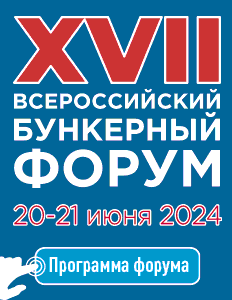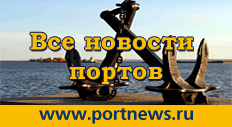НОВОСТИ И СОБЫТИЯ
 16.04.2024
16.04.2024
Лизинговые схемы: возможности для бункеровочного флота. Современные финансовые инструменты и готовые решения для строительства и модернизации бункеровочного флота
 04.04.2024
04.04.2024
ООО "Инфотек Флекс" представит свою продукцию в рамках XVII ВСЕРОССИЙСКОГО БУНКЕРНОГО ФОРУМА (Санкт-Петербург 20-21.06. 2024).
 20.03.2024
20.03.2024
Договорные и внедоговорные аспекты бункеровочной деятельности” – с таким докладом на XVII ВСЕРОССИЙСКОМ БУНКЕРНОМ ФОРУМЕ выступит Константин Путря, к.ю.н. - практикующий юрист и партнер юридической фирмы NAVICUS.LAW, специализирующейся на морском праве.
 27.01.2024
27.01.2024
В законодательстве о Реестре поставщиков бункерного топлива ожидаются изменения

21.12.2023
21 декабря 2023 г. Совет единогласно принял в члены Ассоциации АО «ПНТ-Сервис»
 12.12.2023
12.12.2023
РБК: Reuters узнал об исключении из новых санкций запрета на продажу танкеров
 07.12.2023
07.12.2023
Опубликованы фотографии с приема СРО «Российская Ассоциация Морских и Речных Бункеровщиков».
 28.11.2023
28.11.2023
Деловой прием СРО «Российская Ассоциация Морских и Речных Бункеровщиков» успешно прошел 23 ноября.
 21.11.2023
21.11.2023
23 ноября 2023 года состоится Деловой прием «Цены на нефтепродукты в условиях глобальные мировых потрясений. Финансовые инструменты на российском бункерном рынке»
АРХИВ НОВОСТЕЙ - 16.01.2006
Одна страна, четыре рынка
ONE COUNTRY, FOUR MARKETS
Bunkering in Russia is about more than just St Petersburg. Now a new organization looks to unite the players.
Because of its size and geographical position, Russia has four very distinct bunkering markets. These include the Baltic, where bunkering is dominated by St Petersburg, the Black Sea to the South, the North Pacific coast to the East, and, to the North, the Arctic ocean. Accordingly, although some big players, such as Lukoil, operate in ports throughout Russia, there is also a large number of regional players. Price also varies greatly throughout the country, says Anna Zhigulina of Lukoil, according to the distance between the refinery and port, and port features, including ice conditions and weather.
The biggest market of all is in St Petersburg, at the head of the Baltic, The market here has almost doubled in size between 2000, when the total volume delivered annually was 622,000 tonnes of fuel, to almost 1.2 million tonnes in 2003. There is little competition with other ports in the region, says Elena Nagoga of the Baltic Bunkering Corporation, owing to St Petersburg's low prices, and most competition is between suppliers within the port. The market is fragmented between more than 20 individual suppliers - and in contrast to the consolidation of bunker markets elsewhere in the Baltic region, several of these have joined the market since 2001. The major players are the Baltic Bunkering Corporation, with 26 per cent, Eco Phoenix, which has 20 per cent of the market, and Lukoil Neva, which has between 13 and 15 per cent. Newcomer Nevskiy Mazut, which only entered the market in 2003, has 11 per cent of the market. The remaining 21 per cent is split between other, smaller suppliers.
In the North, Murmansk and Archangel are the most important bunker ports, with others at Vitino, Kandalaksha and Onega. Rosneft is developing oil operations in Archangel, and is intending to ship four million tonnes of crude per annum from the port by 2006, which will see a corresponding increase in ship calls. If, as has been predicted, the northern route through the Arctic sea becomes ice-free throughout the year, the ports could assume a much greater importance. In Archangel, bunkering is available both in the ports and OPL in the roads. JSC Bunker Company claims to be the only licensed bunker company operating in Archangels, operating a fleet of two barges. JSC Bunker Company is doubling the size of its Archangel storage facilities to 10,600 cum, says employee Viktor Filatov. Fuel comes from refineries across the region, and is delivered to the port by rail, rather than through a pipeline. Deliveries take place all year, as the port does not freeze. Bunkering is also available direct from the oil company, Rosneft. Murmansk is served by several operators, including Lukoil, Flagship and Spetstekhnologiya, a company that specializes in supplying MGO to the Arctic fishing fleet.
To the east, says Vladimir Karev of supplier and trader Pavino Shipping, the major bunker ports are clustered in the Primorsky Krai area on the Sea of Japan. They include Vladivostok, Nakhodka, Vostochny, Siavyanka, Posyet and Zarubino. To the north of this group is Kholmsk, on the south western coast of Sakhalin island. Further to the north comes Vanino, on the Russian mainland opposite Sakhalin. And farthest north and east of all in this region is the port of Petropavlovsk-Kamchatski in the Bering Sea, on the eastern side of the Kamchatka peninsula.
One of Vladivostok's main advantages is that the port remains lice-free throughout the year. This makes it of particular strategic importance to the Russian navy, as it is the only such port on Russia's eastern coast. Other ports in this cluster, such as Vostochny, have some light ice between December and March. The ice drifts in from the Gulf of Nakhodka but "it doesn't last long", says the port's website, and is unlikely to provide a major hazard to vessels calling there.
On the merchant side, Vladivostok is a major export centre for metal from the Siberian mines, with 63 per cent of the port's export throughput over the last five months consisting of metal ores and products. The whole Primorsky Krai area is well situated for imports from and to Asia. Vostochny port in particular, lying at the end of the Trans-Siberian railway, is an important railhead for reaching the Siberian hinterland, but bulk cargo rather ten containers remains the most important commodity. Coal accounted for almost 90 per cent of the total port throughput in 2003.
Fuel oil in the area comes from one of three Russian refiners, says Kareov, These are Angarsk, owned by Yukos, Komsomolsk-on-Amur, owned by Rosneft, and Khabarovsk, owned by the I Alliance oil company. Most of the refineries are situated inland and well to the north of the Primorsky Krai area. Fuel is delivered to port storage by rail. Final delivery is generally made by barge, although ex-pipe is available in certain cases, says Vladimir. There is only a limited selection of grades on offer, though; "Basically, we offer and sell IFO-180 and MGO," he says. "Other grades, like lOMB or IFO 120-160 are rather difficult to find in large enough I quantities." Pavino itself operates two barges, and supplies between 50,000-60,000 tonnes of fuel per month, mostly in the southernmost port cluster.
The Sakhalin ports, being isolated from the mainland by the sea and by frequent extreme weather, have more problems with supply. At Kholmsk, for example, deliveries are ex-pipe or ex-truck, says Vladimir Karev. At Petropavlovsk, the situation is even more difficult with regard to IFO, so that most of the time only MGO is available.
Since the break-up of the Soviet Union, Russia no longer has such a long coast on the Black Sea, as much of its former coastline now belongs to Georgia and the Ukraine. The major bunker ports here are Novorossiysk and Tuapse, both primarily oil ports. Novorossiysk is the largest crude oil port on the black sea, with an estimated 6,000 ship calls annually. Fuel oil is generally supplied ex-barge, although ex-pipe is available at Novorossiysk's Shesatis terminal.
As well as bunkering along the coast, Russia also has a thriving system of inland waterways. "Russia is an enormous country and we have not only sea ports, but also river ports which are continuously increasing in size and importance," says Vladimir Sergeyev, of Rosmortrans, a bunkering company working in nine ports. "For example, Rostov-on-Don receives and processes Russian and foreign sea-river class vessels with carrying capacity up to 5,000 tonnes. The annual capacity of the port is displaying a tendency to steady growth, and now it's around 1.5 million tonnes of goods per annum. Bunker business on the river has some differences from the same business on the sea - mainly because of longer routes and complicated navigation."
Water transport within Russia has only developed and become profitable within the last 10 to12 years, says Vasiliy Heilo of Lev Ltd, a bunker supplier operating throughout the south of Russia in Rostov-on-Don, Azov, Taganrog and Novorossiysk. The volume of bunker business has increased steadily in line with this development - as has the number of players in the market. "When we entered the market, there was only a low level of competition. However, with time that competition has increased," he says. It has pushed up the level of customer service, too. LEV expects the market will continue to grow, and says challenges for the future include increasing supply to meet this demand, as well as maintaining flexibility and responsiveness to client's needs. It has recently introduced a new bunker tanker to meet demand, bringing total barge capacity to 2,800 tonnes.
Bunkering in the region is generally carried out at specialist quays, rather than when working cargo, says Heilo. A barge service in the roads is also available. Ex-pipe bunkering is not generally available, although the company is exploring the possibility of introducing it.
Rivers are not the only exception to the rule. Kaliningrad is something of an exception in itself. It is a Russian enclave between Poland and Lithuania, unconnected to the Russian "mainland", but with the attraction of considerably lower prices than the surrounding area. Prices look to Rotterdam and the Great Belt, rather than to St Petersburg, says Alexey Shopyrev, senior trader at Flagship, a physical supplier and trader linked to the Mariysky Refinery Plant Group. "We usually operate to Rotterdam prices, less two or three dollars," he says. "St Petersburg is a large, closed market that is not in our area, so their pricing is not so relevant to us.
"Like other ports in the Baltic, we currently need to supply oil with a maximum of 4.5 per cent sulphur. We have had enquiries for 3.5 per cent, but as most of the fuel that we supply is already 1.8 per cent sulphur, we have no problem complying with this. We should be ready to provide 1.5 per cent sulphur fuel next May," he says.
In total, between 70,000 and 80,000 tonnes are supplied in the port per annum. At present, the port is only dredged to 6-8 I metres, but deepening work will begin at the end of the year to increase this to 9-10 metres, which Shopyrev hopes will increase the number of ship calls - and of bunker calls. "We do have clients that refuse to bunker because of depth restrictions," he says. "Maybe we will see a big rise in bunker calls as a result."
Although ships do not usually make bunkers-only calls at the port of Kaliningrad itself, he says, the company has recently started a bunkers-only service at Baltisyk, which also includes OPL bunkering in the roads. The service is exempt from port charges and several vessels have called there to take advantage of the good prices.
The growing importance of the Russian bunker industry has led to the formation of the Association of Marine and River Bunkers. The idea of creating a professional organization of Russian companies working in the field of ship fuel supplying has been under discussion for several years, says Olga Bogacheva, secretary-general of the new Association, but only now is it the right time to do so. "An attempt to set up a Bunker Alliance with headquarters in Moscow was made in 2002, but at that time the idea was not supported by market players. Most likely this was because the market was not ready and companies had not yet set out for themselves where they were moving and what they wanted to achieve with the Association," she says.
However, the situation has moved on since then. In summer 2005, the first constituent assembly took place in St Petersburg, and the Association of Marine and River Bunkers was registered. Members expect that it will gain national status, because already 20 companies from eight regions of Russia from Kaliningrad to the Far East have joined the Association, and another four candidates are waiting for the general meeting to join the community.
. We are working in a period where a business environment is being formed, which means we have to use all our efforts to establish the rules of the game right. In this situation, the voice of the professional community must be heard clearly and distinctly. Bunker companies in Russia are mostly privately owned, and their success is determined not only by good management, but also by the laws currently in force," With this in mind, the Association aims to establish solid relations with state organizations, and to cooperate with influential organizations such as the Association of Russian Ports. This is particularly important in view of the rapid development of the industry, says Sergeyev, who is chairman of the Association. "Our company is rapidly growing, that is why we need a platform for communications with federal authorities, such as Rosmorport, the federal agency for sea and river transport, and the Association is the best one as far as I suppose," he says.
The opportunity to take part in this debate on an international level as a member of IBIA will be discussed at the next meeting of the board of directors to be held on 28 October. The final decision on membership will be taken at the general meeting. "Many members of the Russian Association are IBIA members and find this very fruitful. It seems very natural to join the European community as an official member", says Olga Bogacheva.
Apart from the question of establishing dialogue with the authorities, the Association also aims to set standards and provide some degree of self-regulation, "One of the main topics with which the Association will work very tightly is the quality of bunker fuel," says Sergeyev. "It's no secret that the attraction of any port is influenced by the quality of bunkers and related services. Any claim or problem from a ship or client is followed by a huge echo and has negative effects for the business of every market player. It's also no secret that these incidents often are grossly overestimated and not very true information is widespread. The aim of the Association is to create an atmosphere that will push everyone to work bona fide."
This self-regulatory dimension is also emphasised by AlexeyBelov, vice precedent of the Association, and a lawyer with ECO Phoenix Holding: "We intend to set out ethical principals for Association members and create a monitoring center, which will fix unfair work - delivery of poor quality fuel, non-payment, etc. We will make a corresponding page on our website. Frankly speaking I don't think we will have too much information to publish, but it's important to have this service existing," he says.






















